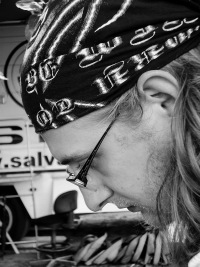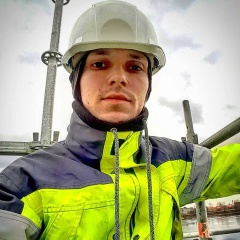За дополнением приятных впечатлений от столицы третьей отправился я во вторую - Тракай. На самом деле будет не совсем корректным называть этот маленький городок бывшей столицей Великого княжества Литовского, потому что неподалеку от него находится село Старый Тракай - действительно подлинное историческое место, бывшее хоть и недолго резиденцией князя Гедимина, но увы несохранившееся. Новый Тракай, или же просто Тракай стал известен позже, во времена Витовта. Здесь он собирал и готовил войско перед Грюнвальдской битвой 1410 года. Здесь он и скончался в 1430-м. Еще при отце Витовта Кейстуте началось строительство двух замков в Тракае: островного и полуостровного. Свою основную роль они потеряли сразу после ликвидации Тевтонского ордена, а в 1655-м году и вовсе были разрушены во время русско-польской войны. Однако, в 70-х годах ХХ столетия состоялась долгожданная реставрация островного замка и ныне, как предполагается, ему возвращен тот вид, который имелся у него в ХV веке. Итак, электричка за полчаса перенесет тебя в небольшой вытянутый вдоль двух озер населенный пункт, где кроме замка на острове можно увидеть домики караимов, их молельный дом - кенассу, католическую церковь, остатки полуостровного замка ( усиленно возрождаемого), а также замечательную природу, уточек, лебедей. Ну и всегда есть потрясающая возможность искупаться!
To add some pleasant impressions from the capital of the third, I went to the second - Trakai. In fact, it would not be entirely correct to call this small town the former capital of the Grand Duchy of Lithuania, because not far from it is the village of Old Trakai - a truly genuine historical place, which, though not for a long time, was the residence of Prince Gediminas, but alas, it did not survive. New Trakai, or simply Trakai, became known later, during the times of Vitovt. Here he collected and trained the army before the Battle of Grunwald in 1410. Here he died in 1430. During the reign of Vitovt's father Keistut, the construction of two castles in Trakai began: an island and a peninsular one. They lost their main role immediately after the liquidation of the Teutonic Order, and in 1655 they were completely destroyed during the Russian-Polish war. However, in the 70s of the twentieth century, the long-awaited restoration of the island castle took place and now, as it is assumed, it has returned to the form that it had in the fifteenth century. So, in half an hour, the train will take you to a small settlement stretched along two lakes, where, in addition to the castle on the island, you can see the houses of the Karaites, their prayer house - kenassa, the Catholic church, the remains of the peninsular castle (intensively revived), as well as wonderful nature, ducks, swans. Well, there is always a great opportunity to swim!










У записи 6 лайков,
0 репостов,
254 просмотров.
0 репостов,
254 просмотров.
Эту запись оставил(а) на своей стене Константин Таченко

























![Мария Карпушева [Рыжая] Мария Карпушева [Рыжая]](https://sun9-33.vkuserphoto.ru/s/v1/ig1/kWB-3ZcYmMSXD2rvqZA89YbdDbywJUubofL5Dk85iLCiFcZYfFjEObFROzTXd-ZAn9Ggo5zl.jpg?quality=96&crop=190,0,720,720&as=32x32,48x48,72x72,108x108,160x160,240x240,360x360,480x480,540x540,640x640,720x720&ava=1&cs=200x200)

